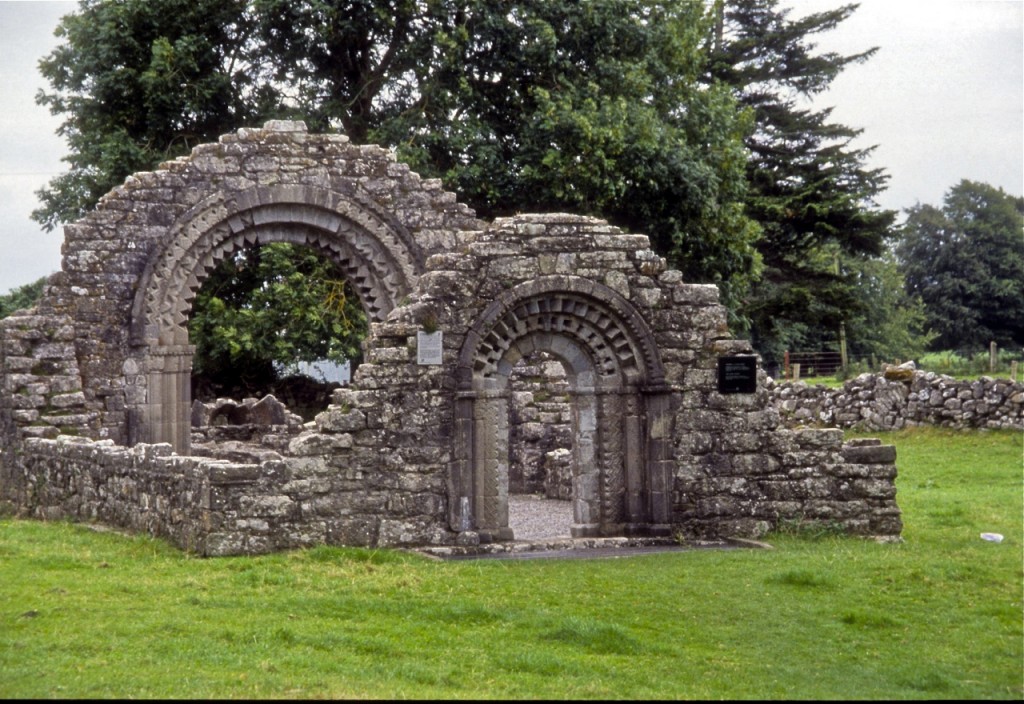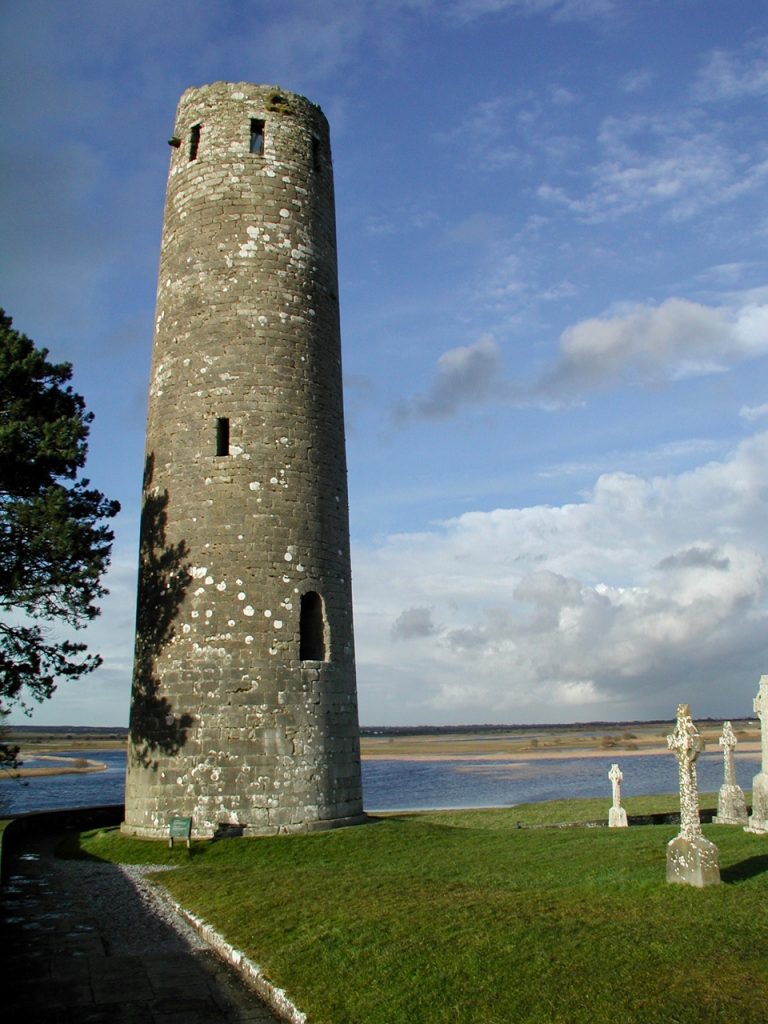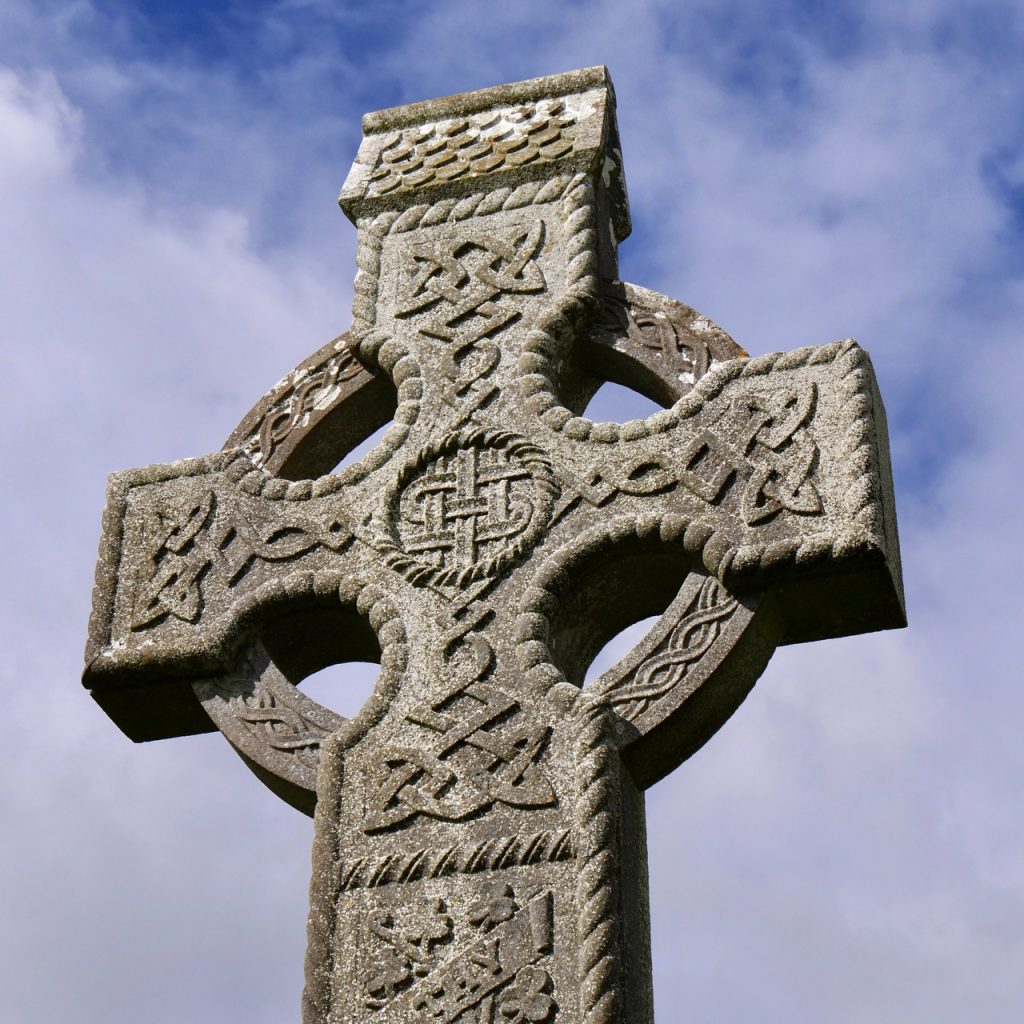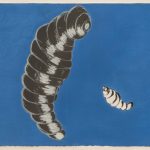Originally posted: March 2016
Nothing beckons me more than the archways of antiquity, so I was charmed by these ruined, but graceful portals that once led into a medieval abbey in Ireland. This one is located at Clonmacnoise, an early Christian site founded by St. Ciarán in the mid-6th century on the eastern bank of the River Shannon.

Just outside of Ireland’s Clonmacnoise Monastery on the banks of the River Shannon are the arches of a ruined Nun’s Chapel, where I discovered a sheela-na-gig, a carved-stone figure of an old woman. ©Laurel Kallenbach
For an hour or more, I wandered through misting rain, winding my way among the ruins of a cathedral, two round towers (built primarily for monks to watch for invaders), numerous Celtic crosses, and ancient grave stones at Clonmacnoise. During the so-called Dark Ages, this religious center was filled with scholarly monks. It was Ireland’s Golden Age of Learning.

Clonmacnoise tower overlooking the River Shannon
Even today, this home of the 6th-century saint Ciarán is revered. In Temple Ciarán, where the revered saint is believed to be buried, farmers still gather clay from around the ruins of the church and place it at the four corners of their fields as a blessing.
In Search of a Sheela-Na-Gig
The historic architecture there was more than enough to make Clonmacnoise a part of my itinerary, but I was also on a quest to find an odd detail carved into the arch. The carving is known as a sheela-na-gig, a stone figure of a naked, old woman squatting and displaying her vulva.
These somewhat grotesque female figures are usually found on Norman or Romanesque churches, usually over a door or window. It may seem like a strange thing to put on a church, yet there are many in Ireland, and while I was visiting, I wanted to see as many of them as I could.
After exploring the Clonmacnoise museum and monastery ruins, I headed east along the pilgrim’s path and out of the officialClonmacnoise site. Down the road a short way was a 12th-century chapel for nuns.
No one else was at the Nun’s Church while I was there, so I wandered around trying to locate the sheela-na-gig, which my guidebook said was located in the arch. (As you can see from the photo above, there’s more than one arch!) Soon I had a crick in my neck from looking up. Frustrated and impatient, I decided to start calling out “sheela!” as I circled around the whole ruin. It took a bit longer, but at last I spotted her amid the many carvings on the outer ring of the chapel’s lintel.

An Irish sheela-na-gig, carved into the front arch of the Nun’s Chapel in Clonmacnoise. This is a closeup; the actual size of the sheela was probably only five inches in the diamond. You can see her face and just make out her feet behind her head, with a display of her crotch below. ©Laurel Kallenbach
If I hadn’t seen pictures of this sheela-na-gig in books, I wouldn’t have recognized her, because she has a very stylized, smiling face surrounded by what I guess are her legs wrapped yoga-style behind her head. At last I was beholding a sheela in situ. Although I’d seen a number of them at the National Museum of Ireland in Dublin, there’s just nothing like locating a piece of art in its natural habitat!
There were actually two other faces lower down that frankly looked more like a sheela-na-gig than the real one—round head, pronounced ears, and deep eyes—except the rock carving stopped at the neck; there was no lower body.
So what’s the significance of a sheela-na-gig, and why is she clutching her genitalia? No one really knows, but there are many theories:
• Sheelas are like gargoyles, designed to ward off evil spirits or to warn people of the perils of lust.
• They are fertility symbols. This theory seems unlikely, because sheelas rarely have breasts and their boney ribs, bald heads, and almost skeletal features are often depicted. There’s nothing sexy about a sheela-na-gig.
• Sheelas are a depiction of an ancient Irish crone goddess, Cailleach, who was very powerful and could sometimes appear as a comely maiden, a mother, or a grandmother. This last goddess theory is the one that interests me most. In medieval Ireland, people often embraced both Christian and pagan beliefs, and the two merged. I’m fascinated by the Divine Feminine, and I like the thought of there being a fierce hag warrior on castles and churches throughout Ireland and Great Britain.
In case you think me batty, I can tell you that I’m not alone in my fascination with sheelas. There are sheela-na-gig T-shirts, hoodies, and necklaces. And singer PJ Harvey wrote and performed a song called “Sheela-na-Gig” back in 1992. (Read more about this topic at my post, My Hunt for Sheela-Na-Gigs). You can see 3-D images of some of Ireland’s sheela-na-gigs that are in the National Museum of Ireland in Dublin.

If you like Celtic crosses, the Clonmacnoise Monastery is a wonderful place to see them.
I’ll always remember Clonmacnoise fondly, especially because it was the first time I’d ever seen a sheela-na-gig “live,” outside of a museum.
—Laurel Kallenbach, freelance writer and editor
Clonmacnoise is located 21 kilometers from Athlone, in County Offaly. The Nun’s Chapel is just outside the main gates of the Clonmacnoise complex. For more information about travel in Ireland, visit Tourism Ireland.
Read more about my travels in Ireland:
- My Hunt for Irish Sheela-Na-Gigs
- Jedi Knights Arrive in Ireland
- An Irish Dolmen and a Magical Dog
- Full Circle: Standing Stones & Driving in Ireland
- Take a Celtic Seaweed Bath on Ireland’s Coast
- On Downings Beach
- Legendary Green Spa in Ireland
- Time Traveling to Ireland’s Temple House
- A Visit to Mythic Ireland




Saints alive! Naughty bits on a church…WTF??
Well, next I’ll post a couple of photos of other sheela-na-gigs that I visited in Ireland. You can see them a lot better, although some…ahem…details have weathered.
Such an interesting take on Sheela-ne-gigs. You bring an interesting merging of art, history and lore, which always are of interest to me.
Wish i cold go to Ireland again. I could never have too much of it. Did you see the Nature program on the river Shannon? 2 parts. So very excellent.
All best to you Laurel, keep on traveling and writing, you enrich my life.
Thanks! And no, I didn’t see the Nature program about River Shannon, but it sounds great. Best to you, too, Jean! Happy travels!